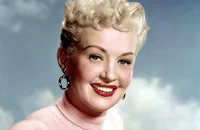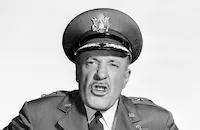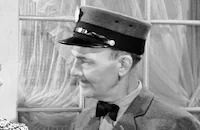Meet Me After the Show

Brief Synopsis
Cast & Crew
Richard Sale
Betty Grable
Macdonald Carey
Rory Calhoun
Eddie Albert
Fred Clark
Film Details
Technical Specs

Synopsis
Broadway star Delilah Lee deeply loves her husband, producer-director Jeffrey Ames, but is tired of the widely circulated story that Jeff discovered her in a seedy Miami nightclub and transformed her into a classy entertainer. Jeff, who is so busy that he neglects his beautiful wife, disparages her superstitious reliance upon her "lucky" garter and declares that she is a success because he made her one. Delilah, whom Jeff calls "Sheba" in private, is still being romantically pursued by singer Chris Leeds, whom she met in Miami one month before she met Jeff, but she gently discourages his attentions. Delilah is infuriated to learn that Jeff lied to her about the backer of their current show, and that the real backer is sexy Gloria Carstairs. When Delilah catches Gloria giving Jeff a steamy kiss, she files for divorce, and Jeff is served with the papers during a performance. Jeff complains to his lawyer and friend, Timothy Wayne, who advises him to apologize. Protesting his innocence, Jeff refuses, and later, Delilah tells Tim that she and Jeff have drifted apart, and that Jeff was obsessed with changing her. Tim urges Delilah to rediscover the things that made her and Jeff fall in love, and tells her about an amnesiac who fell in love with him. With neither Jeff nor Delilah willing to apologize, their case is brought to court, where the judge awards Delilah $2,500 a month in maintenance. The irate Jeff is further antagonized when Delilah, hoping to get him to capitulate, arranges for a doctor's excuse to get her out of her contract with the show. With Delilah not performing, the show loses money and Jeff falls behind in his alimony. Hoping to prove that Delilah is not ill and can return to work, Jeff takes her out to a nightclub and tricks her into singing. Delilah, who had been hoping for a reconciliation, is crushed when she uncovers Jeff's ruse and has him arrested for failing to pay the alimony. Tim bails Jeff out of jail, and Jeff bitterly declares that he will engineer a marriage between Delilah and Chris to end his alimony payments. Jeff assures Chris that he is going to divorce Delilah, but as they are talking, they learn that Delilah has been injured in a car accident. They race to the doctor's office and learn that Delilah suffered a concussion and might have amnesia. Delilah has fled, however, and when Jeff goes to her apartment, he learns that she did not recognize her maid Tillie and then left town. Jeff and Chris discover that under her original name, Kitty Lee, Delilah has gone to Miami, and they follow on the next plane. After a long search, they find Delilah singing in her old nightclub and acting as if she has no memory of the previous seven years. Delilah does remember Chris but Jeff is upset when she does not remember him and ignores him. Suspecting that Delilah is faking, Jeff keeps a close eye on her and is annoyed when she dates David Hemingway, a good-looking but unambitious yachtsman. The next night, Jeff apologizes to Delilah for his earlier behavior, but when she is baffled by his pronouncement, he is convinced that her amnesia is genuine. Delilah then accepts Davey's marriage proposal, and Jeff, desperate to forestall the wedding, promises to get her a job at Miami's biggest hotel. Delilah agrees to postpone the wedding, and her opening night at the hotel is a smash. Delilah's exuberant performance makes Jeff realize that her stardom is the result of her talent, not his, and that she would have been a star regardless of his help. Determined to win her back, Jeff is horrified when Delilah announces that she is leaving with Davey in the morning, and that she wants him and Chris to accompany them to give her away. In the morning, the trio board Davey's tiny "yacht," and when Jeff ridicules the boat, Delilah finally slips up and reveals that she has been faking her amnesia. Davey tries to sock Jeff for insulting Delilah but winds up in the water, and when Jeff dives in to rescue him, Delilah accidentally hits him on the head with an oar. Later, at the hospital, Delilah and Chris learn that Jeff is suffering from a real case of amnesia. Delilah is grief-stricken, and over the next few weeks, lovingly tends to Jeff while his memory slowly returns. On the night that the show re-opens, Delilah wishes that Jeff would once again call her Sheba, and he watches from the wings as she performs. When the finale is over, Jeff embraces Delilah and calls her Sheba, and with his health restored, happily joins her onstage for a curtain call.

Director
Richard Sale
Cast

Betty Grable

Macdonald Carey

Rory Calhoun

Eddie Albert

Fred Clark
Lois Andrews
Irene Ryan
Steve Condos
Jerry Brandow

Arthur Walge
Edwin Max
Robert Nash
Don Kohler
Rodney Bell
Harry Antrim
Jewel Rose
Carol Savage
Michael Darrin
Joe Haworth
Perc Launders

Gwen Verdon
Harry Seymour
Herbert Moorhouse
Fred Kelsey
Billy Newell
John Hedloe
Max Wagner
Gordon Clark
Jack Mather
Don Gray
Ralph Montgomery

John Butler
William Johnstone
Charles Woolf
Al Murphy
Lovyss Bradley
Dick Cogan
Crew
Arthur E. Arling
Angie Blue
Marie Bryant
Jack Cole
Billy Daniels
Ken Darby
W. Scott Darling
Leonard Doss
Bernard Freericks
Earle Hagen
Roger Heman
George Jessel
Harmon Jones
Hal Klein
Erna Lazarus
Charles Lemaire
Thomas Little
Mary Loos
Ray Mala
Lionel Newman
Ben Nye
Ralph Rainger
Enrico Ricardi
Leo Robin
Richard Sale
John Scott
Walter M. Scott
Fred Sersen
Al Siegel
Herbert Spencer
Jule Styne
Travilla
J. Watson Webb Jr.
Lyle Wheeler
Joseph C. Wright

Film Details
Technical Specs

Articles
Meet Me After the Show
By the time she signed on for Meet Me After the Show (1951), Grable had, at age 35, summited the apex of her career and was looking at the downward slope, an indicator of both changing tastes and her own fatigue. While the project was in preproduction, and known as Don't Fence Me In, Cary Grant was announced as Grable's probably leading man; that Macdonald Carey was cast in that role is an indicator of its loss of prestige. Directed with verve by Richard Sale and enlivened by dance numbers choreographed by Jack Cole, Meet Me After the Show offered a frothy show-behind-the-show romantic four-hander involving husband and wife Carey and Grable spicing up their marriage with the intervention of interested parties Rory Calhoun and Lois Andrews. (Grable had lobbied unsuccessfully to have Dale Robertson cast in the role that went to Calhoun.) Turning up in smaller roles are Irene Ryan, a decade away from attaining pop culture immortality as Granny Clampett on the TV sitcom The Beverly Hillbillies, and dancer Gwen Verdon, who pops up for the number "No Talent Joe"; then best known as Jack Cole's assistant, the vibrant, redheaded specialty dancer would enjoy breakout success on Broadway in 1953 in Cole Porter's Can-Can.
Meet Me After the Show proved to be another feather in Betty Grable's cap but the Girl with the Million Dollar Legs demanded a much-needed break, dropping out of Richard Sale's The Girl Next Door (1953) and bequeathing her role to June Haver. (As fate would have it, that production marked Haver's Hollywood swan song as well.) Grable was lured out of retirement with the hope of a lead role in Howard Hawks' Gentlemen Prefer Blondes (1952) but she was eclipsed by the younger Marilyn Monroe. Defying Hollywood gossip that maintained there was a rivalry between them, Grable urged Monroe on, saying "I've had mine - now go get yours." Grable and Monroe acted together in Jean Negulesco's hit How to Marry a Millionaire (1953) and were slated to reteam for Nunnally Johnson's How to Be Very, Very Popular (1955) - a precursor of Billy Wilder's Some Like It Hot (1959), in which the stars would impersonate college boys to outwit a gangland murderer - but Monroe backed out of the deal at the last minute and was replaced with Sheree North. Retired from films by 1956, Grable died of lung cancer in Santa Monica, California, on July 2, 1973, at the age of 56.
By Richard Harland Smith
Sources:
Betty Grable: The Girl with the Million Dollar Legs by Tom McGee (Welcome Rain Publishers, 2009)
Marilyn Monroe: The Biography by Donald Spoto (Cooper Square Press, 2001)

Meet Me After the Show
Quotes
I whipped her into shape with my bare hands!- Jeff Ames
You did? *Nice* job!- Tim Wayne
Mrs. Ames, if you sit around here much longer, moss will be growing on your north side.- Tilly
Men are nothin' but trouble, trouble, trouble. A horse is a good clean animal.- Delilah Lee
Take your fingers out of your mouth, buster, and speak up. I wouldn't bite you... even if you appealed to me.- Delilah Lee
Trivia
Notes
The working title of this film was Don't Fence Me In. As the opening title cards appear, an offscreen chorus sings "Ladies and gentlemen, Twentieth Century-Fox presents Betty Grable, Macdonald Carey in Meet Me After the Show, baby, meet me after the show." According to a modern source, Cary Grant was originally considered for the male lead, and Betty Grable suggested Dale Robertson for the part of "David Hemingway." On November 11, 1950, Los Angeles Examiner reported that Rod Cameron and John Lund had been cast as Grable's co-stars. Although Hollywood Reporter news items include the following actors and dancers in the cast, their appearance in the completed picture has not been confirmed: Snub Pollard, Bernard Elmore, Joe Evans, Al Klein, George Boyce, Joe Niemeyer, Jess Mendelson, Jack Fisher, Bob Schwartz, Herman Boden, Malcolm Breener, John Weideman, Gordon Hanson, J. C. Tedlie and Frank Radcliffe. Hollywood Reporter news items also announced that Dave Hudkins and his band and Bernie Billing's Dixieland Band had been signed for musical numbers, but their appearance in the released film also has not been confirmed.
Noted dancer Gwen Verdon, who was often credited as Gwyneth Verdon on 1950s CBCS, did not receive an onscreen credit for Meet Me After the Show, but was listed in a program for the final production number, which reads, "Delilah Lee and Dancers with Gwen Verdon." According to a modern source, Metropolitan Opera star Robert Weede served as Macdonald Carey's and Eddie Albert's vocal coach.














